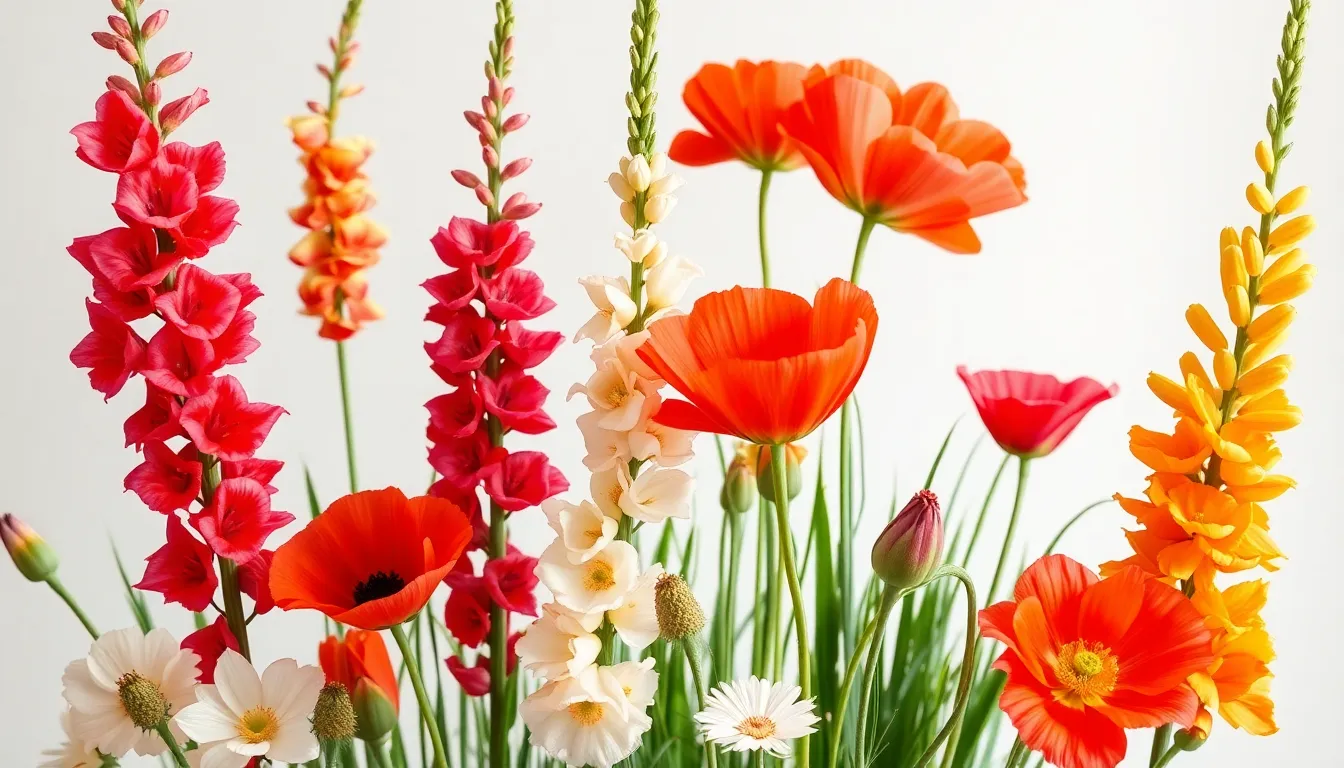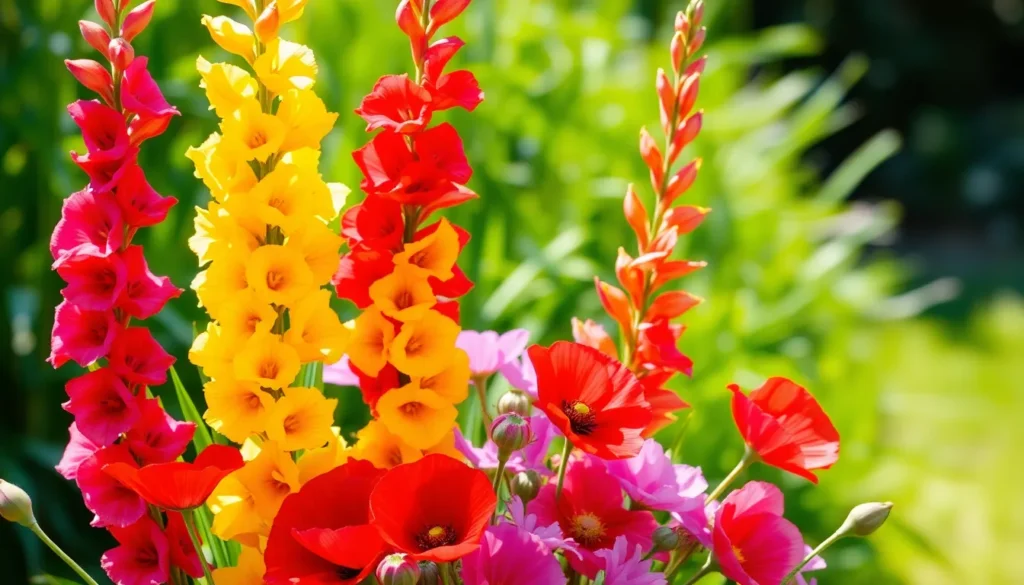Table of Contents
ToggleAugust brings a burst of color and meaning with its unique birth flower, the gladiolus. Known for its tall stalks and vibrant blooms, this flower symbolizes strength, integrity, and sincerity. Those born in this summer month can proudly embrace the gladiolus as a reflection of their personality traits and life experiences.
Additionally, the poppy serves as another birth flower for August, representing imagination and creativity. With its delicate petals and rich history, the poppy adds a layer of charm to the month’s floral symbolism. Exploring the meanings and characteristics of these flowers can deepen one’s appreciation for the beauty of August and the significance behind each bloom.
Overview of Birth Flowers
Birth flowers reflect individual characteristics and traits, offering a deeper connection to one’s birth month. Each month has designated flowers, with distinct meanings associated with them. For August, the gladiolus and the poppy stand out for their vibrant appearances and rich symbolism.
- Gladiolus: The gladiolus symbolizes strength, integrity, and sincerity. These tall flowers come in various colors, each carrying its own significance. This flower represents the determination and resilience of those born in August.
- Poppy: The poppy embodies imagination and creativity. Its delicate petals and bright colors evoke passion and warmth, resonating with the artistic and inventive nature often found in August-born individuals.
Understanding the meanings behind these flowers enhances appreciation for their beauty and significance. These botanical representations serve not only as gifts but also as reminders of the unique traits associated with August birthdays.
What Is the August Birth Flower?

The birth flowers for August are the gladiolus and the poppy. Each flower carries distinct meanings that resonate with those born in this month.
Meaning and Symbolism
The gladiolus symbolizes strength, integrity, and sincerity. Its tall stalks and vibrant hues reflect determination and resilience, qualities often associated with August-born individuals. Each color of the gladiolus conveys specific meanings: pink represents femininity, red signifies passion, and yellow denotes cheerfulness.
The poppy conveys imagination, creativity, and warmth. Its delicate petals evoke a sense of passion, aligning with the artistic spirit commonly found in August birthdays. The red poppy specifically symbolizes remembrance, while pink relates to compassion and hope.
Varieties of the August Birth Flower
Various types of gladiolus exist, including:
- Gladiolus hortulanus: Often used in gardens for its colorful blooms.
- Gladiolus murielae: Known for its white flowers and sweet fragrance.
- Gladiolus primulinus: Esteemed for its bright yellow shades.
Poppies also come in several varieties:
- Papaver somniferum: This variety includes the classic red poppy, known as the opium poppy.
- Icelandic poppy (Papaver nudicaule): Carries bright, multi-colored blossoms.
- California poppy (Eschscholzia californica): Recognized for its vibrant orange flowers and state flower of California.
Understanding these varieties enhances appreciation for the beauty and diversity of the August birth flowers.
Historical Significance
The historical significance of the August birth flowers, gladiolus and poppy, showcases their deep-rooted connections to various cultures and traditions.
Cultural Associations
Gladiolus and poppy hold strong cultural associations across different civilizations. In ancient Rome, gladiolus represented the power and strength of gladiators, symbolizing valor and honor. In Victorian England, the flower conveyed messages of sincerity and faithfulness, often used to communicate emotions in floral arrangements. Poppies, on the other hand, link to themes of sleep and death in Greek mythology. They served as offerings to the dead, symbolizing eternal rest. Various cultures also view poppies as symbols of remembrance for those who sacrificed their lives in wars, especially through the popularization of the red poppy after World War I.
Folklore and Myths
Folklore surrounding these flowers enriches their historical narrative. Gladiolus, often associated with its sword-like shape, carries legends depicting it as a protective talisman in battles, believed to grant strength and courage to warriors. In contrast, poppies feature prominently in myths, notably the Greek tale of Demeter and Persephone, where they are said to have sprung from Demeter’s tears, representing a blend of beauty and sorrow. Additionally, ancient Egyptians used poppies in rituals, viewing them as plants that eased the passage into the afterlife, further enhancing their mystical aura.
Care and Growing Conditions
Gladiolus and poppy thrive under specific care and growth conditions that enhance their vibrant beauty. Understanding these requirements ensures successful cultivation for August flower enthusiasts.
Ideal Soil and Watering
Gladiolus prefers well-draining soil enriched with organic matter. The optimal pH ranges from 6.0 to 7.0. Poppies flourish in sandy, loamy soils that allow for aeration and drainage. Regular watering is crucial; gladiolus requires consistent moisture, especially during active growth. Watering should be sufficient but not excessive to prevent bulb rot. Poppies, in contrast, tolerate drier conditions and require moderate watering, especially during germination. Mulching can regulate soil moisture levels and suppress weeds effectively.
Sunlight and Temperature Requirements
Both flowers thrive in full sun, needing at least six hours of direct sunlight daily. Gladiolus benefits from warmer temperatures, preferring conditions between 65°F and 75°F (18°C to 24°C). It does well in zones 7-10. Poppies favor slightly cooler temperatures, ideally between 55°F and 70°F (13°C to 21°C) and can flourish in zones 3-10. During hot summer months, providing partial shade can help maintain optimal growth for both flower types.
Uses and Arrangements
Gladiolus and poppy offer various uses in floral arrangements and contribute to mental and emotional well-being.
Floral Arrangements for Celebrations
Floral arrangements featuring gladiolus and poppy serve as striking centerpieces for celebrations. Gladiolus, with its tall and elegant spikes, adds height and drama to bouquets, making it ideal for weddings and formal events. Poppies, with their soft, delicate petals, bring a touch of whimsy and color. These flowers can be combined in mixed arrangements or used separately for themed displays. Common uses include:
- Weddings: Gladiolus symbolizes love and sincerity, while poppies represent creativity, making them perfect for bridal bouquets and centerpieces.
- Birthdays: Arrangements featuring the bold colors of gladiolus and the cheerful hues of poppies celebrate August birthdays uniquely.
- Funerals: Both flowers convey deeper meanings; gladiolus represents strength and remembrance, while poppies symbolize eternal rest and peace.
Therapeutic Benefits
Gladiolus and poppy also provide therapeutic benefits, enhancing mental and emotional well-being. Certain studies suggest exposure to flowers positively affects mood and reduces stress. Floral elements of these flowers include:
- Aromatherapy: Poppy seeds, when used in essential oil form, may promote relaxation and reduce anxiety, fostering a calming environment.
- Art Therapy: Incorporating images or arrangements of gladiolus and poppy into creative projects aids in expressing emotions and encouraging mindfulness.
- Healing Spaces: Placing these flowers in homes or healthcare settings can uplift spirits and create a rejuvenating atmosphere.
Understanding the uses and arrangements of gladiolus and poppy highlights their significance in both celebration and healing.
August’s birth flowers—the gladiolus and the poppy—offer a rich tapestry of meaning and beauty. These flowers not only symbolize strength and creativity but also carry deep cultural significance. Their vibrant colors and unique characteristics reflect the qualities of those born in this month.
By understanding the symbolism and care requirements of these flowers, individuals can appreciate their beauty in both gardens and floral arrangements. Whether used for celebrations or as symbols of remembrance, gladiolus and poppy hold a special place in the hearts of many. Embracing these flowers enhances the connection to August’s unique traits and the joy they bring.




